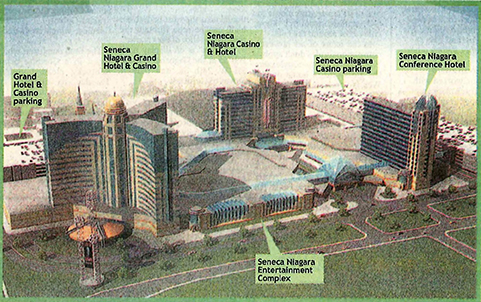SENECA DELIVERS EMPTY PROMISES, LEAVES TAXPAYERS HOLDING BAG
By Mike Hudson
 |
The plan above was used to help persuade a state judge to evict Americans out of thier businesses and homes through eminent domain. It may have been the first time Americans were forced out of thier property, by an American court, so a Sovereign Nation could take their property out of America and make it Sovereign land. The judge was no doubt persuaded by the ambitious plan. But it was bogus plan. Nothing was built. Maybe that was a good thing, for it would have been reason, for tourists and locals alike, to spend money inside the tax-free Seneca nation and not at struggling, local, taxpaying businesses. Some believe Seneca do not intend to make Seneca Niagara a tourist destination, but are content to target locals. Instead of developing their 50 acres in the Falls, Seneca built casinos in Buffalo and Salamanca, targeting locals. Their casino business model has been described by industry insiders, like Mickey Brown, thier first manager, as “the grind,” where you operate mainly for locals, who regularly lose modest to large amounts of money, on small bets, year in and year out. |
Just how extravagant were the claims by the Seneca Nation of Indians about the extent to which they would develop the 50 acres in downtown Niagara Falls given to them under an agreement with the state?
It’s an important question, since it goes directly to the heart of how the deal was done and how the taxpayers of Niagara Falls were left holding the bag for a glitzy attraction that has failed miserably in generating revenue for city coffers and spin-off businesses for a neighborhood that continues to look as creepy as it ever did.
In 2006, a set of plans came to light that had been kicking around for awhile. The plans called for nearly 250,000 square feet of new construction in addition to the convention center casino, parking ramp and hotel that were already built by that time, an interconnected complex of hotels, entertainment venues, restaurants and other attractions that would give visitors to the cataract city reasons to come for an extended stay.
“From what I’ve seen and read, it’s very similar to what you see in the (Foxwoods Resort Casino) in Connecticut,” former city tourism director David Rosenwasser told a reporter at the time. “It’s a giant facility, with every component connected together… That’s been a very successful model at Foxwoods.”
Seneca officials said at the time that the “full build-out” would be a lengthy process, one that wouldn’t be completed until late 2011.
Like many other deadlines for construction set by various charlatans in recent decades, the one for the Seneca casino complex came and went with nary a shovel breaking the ground.
Prominent local attorney John Bartolomei predicted the Seneca plan was made up of a lot of hot air.
“I was pretty excited to see this grand plan you have for a project that would benefit the City of Niagara Falls, an economic development project that these lands you want to take would fit within, and how exciting it would be for me to see all these great things that would be done for the city,” he told state officials. “But I told you it was a bad day, because what I found was a bunch of nonsense.”
The plan called for a 97,200-square-foot Grand Hotel and Casino. Construction was to have begun in April, 2007, and an opening by December of 2008. Furthermore, an entertainment complex and a conference hotel with a new parking ramp were promised that would have added another 111,300 square feet to the project.
At the time, the Seneca’s were looking to have the state enforce the eminent domain provisions of the casino compact.
Homeowners and businesses were thrown off of property they’d owned in some cases for decades, the promised new construction to replace their decrepit structures with gleaming viability.
Thousands of new employees would be needed to keep the operation going on a 24/7 basis, the Seneca’s said, and additional money generated by the increased number of slot machines on the site would provide funding for city programs for years to come.
Falls’ landowners fought for their properties. Phillip and Sharon Buss, who operated the Endtime Handmaidens and Servants International ministry out of a home on what used to be Sixth Street, actually took the Seneca’s to court.
“We’re not here to get involved politically,” Sharon Buss said at the time. “We want to see the ministry grow here. We don’t want to be at odds with our neighbor.”
In the end, the couple lost their property, as did the owners of a number of other parcels contained within the Seneca casino “footprint.” Sixth Street was supposed to have been the site of a new parking garage. It was never built, and neither has anything else.
Nobody wants to be at odds with their neighbor. But the Seneca Nation of Indians has made it pretty difficult to do anything else.